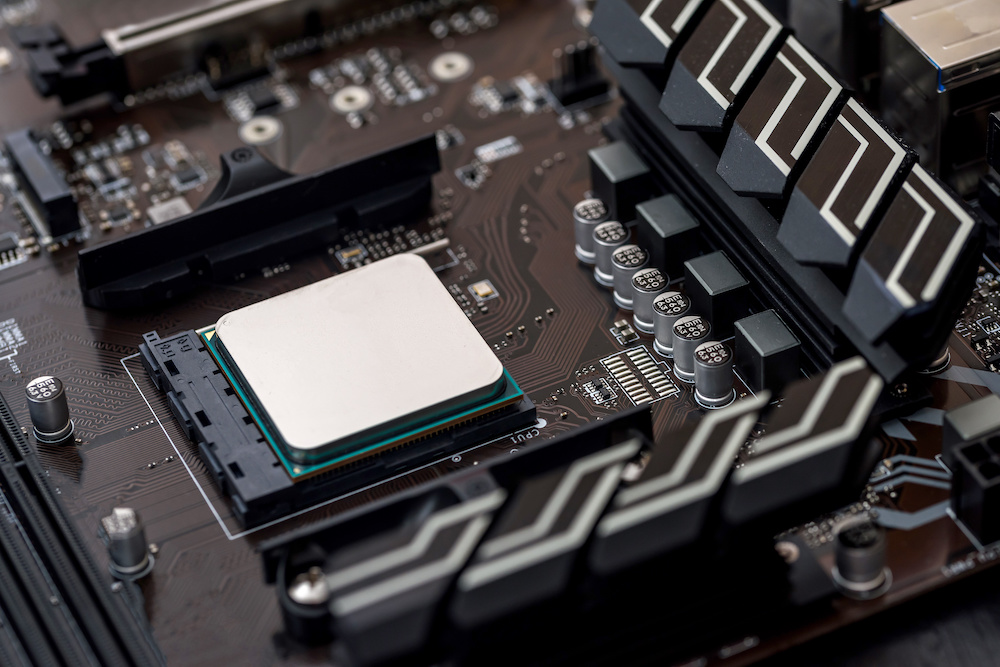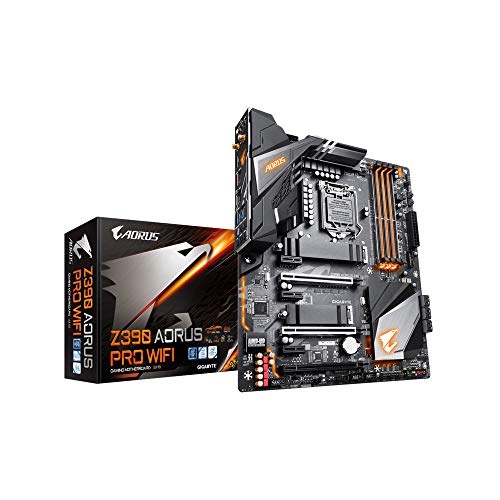Best Motherboard for i5 9600k: Complete Reviews With Comparisons
We may earn a commission for purchases using our links. As an Amazon Associate, we earn from qualifying purchases.
Although it is only a mid-range 6-core desktop processor, the Intel Core i5-9600k targets game enthusiasts who understand hardware tweaking basics.
It’s been almost three years since the i5-9600k came out, yet it still provides many consumers with an excellent option for gaming.
To make things easier, only the best motherboards for i5 9600k can help you eke out consistent or better performance over time.
You don’t have to check every compatible motherboard meticulously, as this compilation already narrows it down for you.
The set comprises different Z390 motherboards for a wide range of budgets.
Comparison Chart
Motherboard for i5 9600k Reviews
1. ASRock Z390 Pro4
The ASRock Z390 Pro4 is an ATX motherboard with solid capacitors and a scaled-down heatsink over the PCH.
It is the most budget-oriented Z390 motherboard you could find that works well with the i5-9600k.
Review
The ASRock Z390 Pro4 has a laid-back black PCB with some white decals across the board.
With its four DDR4 memory module sockets, it can hold a total of 128GB of system RAM.
Its max base memory speed of 2666MHz is enough to deliver multiple data streams to the i5-9600k.
Plus, it will even allow overclocking up to 4300MHz.
ALSO READ: Best Motherboard for i7
- Storage and Expansion Options
This motherboard has six SATA 6Gbps ports and two Ultra M.2 sockets.
However, populating the first M.2 slot with a SATA device disables SATA5, and installing a SATA device on the second M.2 slot will disable SATA1.
Otherwise, if a PCIe-type device occupies the second M.2, you can’t use SATA0.
In short, using both M.2 sockets will reduce your SATA drive capacity to four modules instead of six, unless the first socket uses PCIe.
Expansion sockets include two full-sized PCIe 3.0 slots and three PCIe 3.0 x1 slots. You can use a combination of GPUs that support CrossFireX.
Additionally, the expansion area includes an M.2 socket, which ASRock intends for a Wi-Fi adapter.
- Connectivity Features
A drawback of the Z390 Pro4 is the lack of an onboard wireless module. You will have to purchase a compatible Wi-Fi adapter separately.
However, looking at the rear panel, ASRock equips it with a bracket for a Wi-Fi module with dual antennas.
The only network connectivity option you will get is a single LED-lit RJ45 port for the built-in Gigabit LAN module.
Rear panel display connectors include a D-Sub, a DVI-D, and an HDMI.
For audio, the Z390 Pro4 has the fundamental Line in, Front Speaker, and Microphone HD audio jacks.
Peripheral device connectors include a PS/2, two USB 2.0, two USB 3.1 Gen1, and two USB 3.1 Gen2, one of which is a Type-C.
You can have seven more USBs on the front panel through the four onboard USB headers.
PROS
CONS
2. ASUS Prime Z390-A
The ASUS Prime Z390-A is a premium-looking ATX motherboard with massive heatsinks over the VRMs, rear panel I/O, and PCH.
It is not as budget-friendly as the Z390 Pro4, but its more comprehensive feature set more than makes up for the price.
Review
The ASUS Prime Z390-A has fancy-looking RGB lighting built into its main heatsinks, and they stand out against the black PCB.
With a maximum RAM capacity of 128GB and a base memory frequency of 2666MHz, it should compete well with the ASRock Z390 Pro4.
However, its maximum memory overclocking frequency is 4266MHz, a few Hertz slower than the ASRock.
If you choose this motherboard, take advantage of the user-friendly BIOS UEFI, making overclocking with the i5-9600k a lot easier.
- Storage and Expansion Options
Like the Z390 Pro4, the Prime Z390-A has six SATA 6Gbps ports and two M.2 slots.
The first M.2 slot shares bandwidth with the SATA2 port for SATA devices, and the second M.2 does not support SATA storage drives.
If you need to populate all storage connectors, use only PCIe 3.0 devices on the M.2 slots.
For expansion, the Prime Z390-A has three PCIe 3.0 x16 sockets and three PCIe 3.0 x1 slots.
You can use the full-sized sockets for NVIDIA 2-Way SLI or AMD 3-Way CrossFireX multi-graphics setups.
Another similarity with the Z390 Pro4 is the lack of a built-in wireless module.
If you need wireless connectivity, this motherboard will require a Wi-Fi module purchased separately and installed into one of the expansion slots.
- Connectivity Features
The only network connectivity option available to this motherboard is the built-in Intel I219V Gigabit LAN controller.
It features the ASUS Turbo LAN Utility and ASUS LAN Guard, which make wired connections better than what the Z390 Pro4 offers.
The rear I/O panel features the more advanced DisplayPort and HDMI instead of the much older D-Sub and DVI-D.
It also carries premium audio components, including five HD audio jacks and an optical S/PDIF out port.
You can connect your peripheral devices using a PS/2, two USB 2.0, two USB 3.1 Gen1, and four USB 3.1 Gen2. One of the Gen2 USBs is a Type-C.
Lastly, you might also like that the internal connectors will allow up to nine more USB ports.
PROS
CONS
3. ASUS ROG Strix Z390-F Gaming
The ASUS ROG Strix Z390-F Gaming is an ATX motherboard that follows the safe and reliable trend of mid-range ROG boards.
It features significant improvements from its Z370 predecessor, making it more capable of working with the i5-9600k.
Unfortunately, the cost of this motherboard could break the bank for some consumers, and it still lacks some features that alternatives possess.
Review
Unlike the Prime Z390-A, the ASUS ROG Strix Z390-F Gaming is a black motherboard with gray accents and noticeable lighting features on the primary heatsink.
It can bring gaming to a whole new level with the i5-9600k.
What’s more, it can hold 128GB of system memory with a standard base frequency of 2666MHz.
Like the Prime Z390-A, the ROG Strix Z390-F can overclock its memory speeds up to 4266MHz. Plus, it has the same straightforward BIOS UEFI.
With ASUS innovations in the consumer overclocking arena, the ROG Strix Z390-F is perfectly capable of working with the i5-9600k.
- Storage and Expansion Options
The ROG Strix Z390-F Gaming also has six SATA 6Gbps sockets and two M.2 slots.
Also, the configuration settings are similar to the Prime Z390-A.
Using a SATA storage device on the first M.2 slot disables SATA two, and both M.2 slots support PCIe 3.0 devices.
The second M.2 slot cannot accommodate a SATA drive.
Expansion options and multi-graphics support are also comparable, with three PCIe 3.0 x16 sockets and three PCIe 3.0 x1 slots.
Like the first two options, this board does not have a Wi-Fi module.
Given that it is quite pricey, we would have expected it to have wireless connectivity.
Nevertheless, you will have to use one of the expansion slots for a third-party Wi-Fi adapter.
- Connectivity Features
Fortunately for those with the money to spend, this motherboard can provide reliable network connections with the built-in Intel I219V Gigabit LAN controller.
Moreover, the rear panel I/O is as comprehensive as the one on the Prime Z390-A.
This board offers an HDMI and a DisplayPort for display connections and five premium jacks with an optical S/PDIF out port for sound.
For peripheral devices, the rear panel sports a PS/2, two USB 2.0, two USB 3.1 Gen1, and for USB 3.1 Gen2.
One of the Gen2 ports is also a Type-C. Unlike the Prime Z390-A, however, internal connections only allow up to seven ore USBs.
PROS
CONS
4. Gigabyte Z390 Aorus Pro Wi-Fi
Another ATX motherboard fit for the i5-9600k is the Gigabyte Z390 Aorus Pro Wi-Fi.
Unlike the ROG Strix Z390-F Gaming, it is a more inexpensive choice.
It gains some points in the connectivity department, but it does not include some items in the same area to keep the cost low.
Overall, this motherboard is a sturdy and affordable option.
Review
Like all the alternatives, the Gigabyte Z390 Aorus Pro Wi-Fi has a total RAM capacity of 128GB.
Furthermore, it can maintain memory speeds of 2666MHz with the i5-9600k.
However, overclocking memory speeds to the maximum allowable 4266MHz can be tricky, as Gigabyte still has to improve its BIOS interface.
- Storage and Expansion Options
The Z390 Aorus Pro also has the standard six SATA 6Gbps connectors and two M.2 slots.
Expansion slots include three full-sized PCIe 3.0 x16 sockets, and two of them have steel reinforcement.
You can use these expansion slots for multiple graphics cards supporting Quad SLI, 2-Way SLI, Quad CrossFire, 3-Way CrossFire, or 2-Way CrossFire.
Among the options, this board offers the most versatility for multi-GPU setups.
- Connectivity Features
This motherboard’s advantage over the first three options is its built-in dual-band wireless module.
However, its LAN chip is not as good as the ones on the ASUS motherboards.
The board has a single HDMI port on the rear panel, but it sports five audio jacks and an optical S/PDIF out port.
This board does not have a legacy PS/2 combo port.
All you’re getting for peripheral connections are four USB 2.0, three USB 3.1 Gen1, and three USB 3.1 Gen2.
Fortunately, one of the Gen2 ports is the more advanced Type-C. Onboard connectors allow up to seven additional USB ports.
PROS
CONS
5. MSI MPG Z390 Gaming Edge AC
We wouldn’t be ending our list without including an option from MSI.
The MSI MPG Z390 Gaming Edge AC is another ATX motherboard that packs excellent features for the i5-9600k.
It does not cost as much as the ROG Strix Z390-F Gaming, and it offers reliable overclocking capabilities.
Review
The MPG Z390 Gaming Edge AC is an all-black motherboard with great-looking and overtly capable heatsinks.
With the perfect balance of components, this board has all the aspects of a great motherboard.
It has four DDR4 DIMM sockets, which means you can have a total RAM capacity of 128GB.
With the Intel Core i5-9600k processor, you can max out this motherboard’s 2666MHz base memory frequency.
However, since the i5-9600k came out as an unlocked version of the single-threaded Intel Core processors, you will want to take advantage of overclocking.
With a maximum memory overclocking speed of 4400MHz, the MPG Z390 Gaming Edge AC can give you just what you need.
RELATED:
Motherboard for i5 8400 (Guide)
- Storage and Expansion Options
This board does not offer much difference in the storage department with its six SATA 6Gbps ports and two M.2 slots.
Its expansion options, however, are more like those featured on the ROG Strix Z390-F.
It has three full-sized PCIe 3.0 sockets, two of which have metal reinforcements. Additionally, the board has three PCIe 3.0 x1 slots.
- Connectivity Features
This board’s rear panel holds pretty much everything you would want on a motherboard for the i5-9600k.
Network connectors include two Wi-Fi antenna connectors for the built-in Wi-Fi module and included antennas.
Moreover, the board boasts the same LAN controller as the premium ASUS boards.
Display connections are pretty flexible with the built-in DisplayPort and HDMI port.
Unlike the Z390 Aorus Pro, this board includes a PS/2 port. It even retains only two USB 2.0 ports that should be enough for keyboards and mice.
Additional USB ports include two USB 3.1 Gen1 and two USB 3.1 Gen2, one of which is a Type-C.
You can also route nine more USB ports through the internal headers.
PROS
CONS
Final Verdict
Among all these Z390 options, the top motherboard for i5 9600k is the MSI MPG Z390 Gaming Edge AC.
It offers the fastest memory overclock speeds, and it has a more comprehensive feature set than the alternatives.
Furthermore, its performance is pretty comparable to those of similarly priced competing models from other brands.
If you’re looking for alternatives using other chipsets other than the Z390 platform, you might want to check out the best Z370 motherboards.











